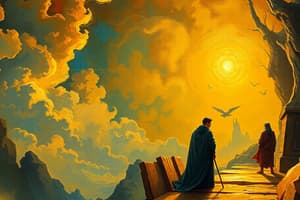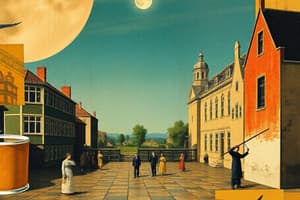Podcast
Questions and Answers
The early renaissance period emphasized complexity and abstraction in painting.
The early renaissance period emphasized complexity and abstraction in painting.
False
Mannerism is characterized by the depiction of human figures using oil paints with warm colors.
Mannerism is characterized by the depiction of human figures using oil paints with warm colors.
True
Baroque paintings are known for being simple and minimalistic.
Baroque paintings are known for being simple and minimalistic.
False
Rococo painting emphasizes the ultimate presentation of urban life.
Rococo painting emphasizes the ultimate presentation of urban life.
Signup and view all the answers
Paul Cezanne is recognized as the Father of Impressionism.
Paul Cezanne is recognized as the Father of Impressionism.
Signup and view all the answers
Vincent Van Gogh is regarded as the Father of Impressionism.
Vincent Van Gogh is regarded as the Father of Impressionism.
Signup and view all the answers
The Middle Kingdom period in Egyptian sculpture is known for individual moods in the faces of statues.
The Middle Kingdom period in Egyptian sculpture is known for individual moods in the faces of statues.
Signup and view all the answers
The New Kingdom period produced statues that were lifelike and depicted various poses.
The New Kingdom period produced statues that were lifelike and depicted various poses.
Signup and view all the answers
The Classical age in Greece was marked by the use of marble in nude male statues.
The Classical age in Greece was marked by the use of marble in nude male statues.
Signup and view all the answers
Egyptian sculpture primarily consisted of palettes, wall carvings, and statues.
Egyptian sculpture primarily consisted of palettes, wall carvings, and statues.
Signup and view all the answers
Study Notes
Renaissance Painting
- Early Renaissance (14th-15th century): Emphasized simplicity, gesture, and expression.
- High Renaissance (16th century): Characterized by deeper pictorial space, dramatic skies with dark clouds and flashes of light.
- Mannerism period: Human figures were rendered with sumptuous, warm, and sensual colors using oil paints.
- Baroque Painting: Ornate and fantastic, appealing to emotion, sensual, and highly decorative. Used light and shadow to create dramatic effects.
Rococo Painting
- Focused on the portrayal of farm and country life.
Romantic Painting
- Explored the artist's personal reactions to past events, landscapes, and people.
19th Century Painting (Modern Art)
- Aim was to please the public.
Impressionism
- Paul Cezanne is considered the greatest Impressionist and the Father of Modern Art.
- Impressionism focused on simplicity, brilliance, perfect balance, bright colors, and depth in art.
Expressionism
- Vincent van Gogh is regarded as the Father of Expressionism.
- Expressionist works are known for their rough beauty, emotional honesty, bold colors, and simplicity.
Development of Sculpture
- Sculpture is an art form that utilizes modeling.
Pre-Historic Sculpture
- Consisted of crude forms carved from stone and wood.
Egyptian Sculpture
-
Developed over four distinct periods:
Old Kingdom Period
- Sculptures developed into forms that influenced the rest of pharaonic history.
First Dynasty Period
- Occurred around 5,000 years ago.
- Common subjects included the sun, moon, stars, and sacred animals.
Middle Kingdom Period
- Statues depicted individual moods, but bodies remained rigid and straight.
New Kingdom Period
- Figures were lifelike and vigorous.
- Depicted in poses like walking, dancing, and bending, showcasing dignity and serenity.
- Forms of Egyptian sculpture include palettes (shield-like pieces of stone with relief carving), wall carvings, and statues.
Greek Sculpture
- Daedalic Period: Marble was widely used as a material. Nude male statues were prevalent.
- Classical Age (Age of Pericles): Temples dedicated to gods and goddesses were adorned with sculptures.
- Later Greek Period: Male and female figures were often depicted with little or no clothing.
Roman Sculpture
- Depicted famous men and women in bust forms, representing their personalities realistically.
Studying That Suits You
Use AI to generate personalized quizzes and flashcards to suit your learning preferences.
Description
Test your knowledge on key art movements from the Renaissance to Impressionism. Explore different styles, techniques, and influential artists through the ages. This quiz covers various periods such as Baroque, Rococo, and Romantic painting.




